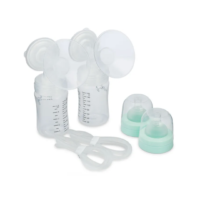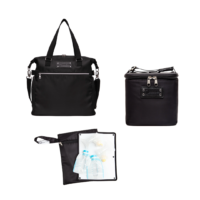Going back to work after having a baby is a whole new experience.
Becoming a working mother can feel like a wild roller coaster ride. You’re likely to experience some emotional swings, and there are plenty of anxieties to navigate. Some moms feel guilty for leaving their newborn. Some moms feel weird about pumping at work. Most moms worry about whether they can do it all, and all those fears and doubts can feel overwhelming at times. Rest assured, however, many working mothers have successfully navigated the challenges of pumping breast milk at work, and with the right strategies and support, you can too.
In this blog post, we’ll explore some of the most effective tips and strategies for successfully pumping breast milk at work, while also addressing the emotional roller coaster that comes with being a working mother. We hope to offer some reassurance and guidance to help you feel confident and empowered as you navigate this exciting, yet challenging, phase in your life.
Step One: Plan ahead.
Before returning to work, research your workplace’s policies on pumping to understand what resources are available to you. This might include information on break times, pumping facilities, and storage options for breast milk. Once you have a good understanding of your workplace’s policies, have a conversation with your supervisor or HR representative about your needs as a breastfeeding mother. If your workplace is aware of your situation, they may be able to offer you a private space to pump, a flexible schedule to accommodate pumping breaks, or additional storage options for breast milk.
Remember: You have legal rights as a breastfeeding mother in the workplace, and your employer is required to provide reasonable accommodations to support your needs. Don’t be afraid to speak up and advocate for yourself if you encounter any challenges or difficulties along the way.
Step Two: Schedule your pumping breaks.
Many moms find it helpful to create a schedule for pumping breaks. This can help you stay organized and ensure that you’re able to pump regularly throughout the workday. You may want to consider scheduling your pumping breaks around your baby’s feeding schedule to help maintain your milk supply and make pumping sessions more efficient. While you’re scheduling, identify a private location where you can pump. This might be a designated lactation room, a private office, or a conference room that can be reserved for pumping. Make sure that the location you choose is clean, comfortable, and equipped with a power outlet and a table or other surface for your breast pump and supplies.
Step Three: Invest in a quality breast pump and accessories.
A good breast pump can make all the difference in your pumping experience, helping you express milk more efficiently and quickly, and potentially reducing discomfort or pain associated with pumping. A double electric pump is a popular choice for working mothers, as it allows you to express milk from both breasts at the same time. This can help you save time and increase milk production. Double electric pumps also offer different suction settings and speed options, which can help you customize your pumping experience to meet your needs.
When choosing a breast pump, it’s important to consider factors like comfort, ease of use, and portability. Look for a pump that is easy to assemble and clean, has adjustable suction levels, and comes with a carrying case or other accessories that make it easy to transport to and from work. Read more on the best pumps for working moms here.
In addition to investing in a quality breast pump, it’s also important to make sure you have all the necessary supplies and accessories to make your pumping experience as smooth and efficient as possible. This might include extra bottles, breast shields, and storage bags or containers.
Step Four: Build up your milk supply.
Building up a reserve of stored breast milk in the weeks leading up to your return to work ensures that you’ll have enough milk for your baby while you’re away. One option is to start pumping a few weeks before your return to work, gradually increasing the frequency and length of your pumping sessions to build up your milk supply. Another option is to add an additional pumping session to your daily routine, either in the morning or at night when milk production tends to be highest.
Remember: Freshly expressed breast milk can be stored at room temperature for up to 4 hours, in the refrigerator for up to 4 days, or in the freezer for up to 6 months. Make sure to label and date each container of breast milk and follow proper storage and handling protocols to prevent contamination.
Step Five: Practice pumping before your first day back.
By practicing pumping at home, you can get used to the pump, learn how to set it up, and develop a routine that works for you, increasing your comfort and confidence. Set aside a time of day when you’re feeling relaxed and comfortable, and when your milk production tends to be highest. This may be in the morning or evening, depending on your baby’s feeding schedule and your own personal preferences. Take the time to experiment with different suction levels, speed options, and breast shield sizes to find what works best for you. Your practice sessions offer a great opportunity to build up a reserve of stored breast milk, which can be helpful for managing unexpected changes in your work schedule or for supplementing your baby’s diet while you’re away.
Step Six: Stay hydrated, nourished, and relaxed.
Your good health is critical in maintaining milk production and making the pumping experience as comfortable and efficient as possible. It’s important to drink plenty of water while pumping at work to stay hydrated and maintain milk production. Aim for at least 8 glasses of water per day, and consider bringing a water bottle with you to work to help you stay hydrated throughout the day. Make sure to have healthy snacks on hand, such as fresh fruit, nuts, or yogurt, to help keep your energy levels up throughout the day. Listen to calming music, take deep breaths, or practice mindfulness techniques to help you relax and stay focused because stress is counter-productive at work and while pumping.
Step Seven: Have a plan for storing and transporting milk safely.
Safe storage and transportation is crucial for maintaining the quality and safety of your breast milk and ensuring that it’s available for your baby when you’re away from home. Label each container with the date and time the milk was expressed, and store the milk in a cool place with ice packs if necessary. When transporting breast milk, make sure to use a cooler or insulated bag with ice packs to keep the milk at a safe temperature. You may also want to consider investing in a specialized breast milk storage bag or container that is designed to keep milk at a safe temperature and prevent spills or leaks.
We’re proud of you, mama!
Going back to work after having a baby is a big adjustment, and it’s natural to feel overwhelmed and anxious at times. However, it’s important to remember that being a working mother is something to be proud of. You are not only providing for your family financially but also setting a great example for your child. Embrace your dual roles as a mother and professional, and don’t feel guilty about taking the time to pump breast milk for your baby. You deserve to have the resources and support you need to make the transition as smooth as possible. At Milk N Mamas Baby, we are committed to providing you with the best tools and resources to help you feel confident, empowered, and successful in both your personal and professional life. Remember, you’ve got this, and we’re here to support you every step of the way.








